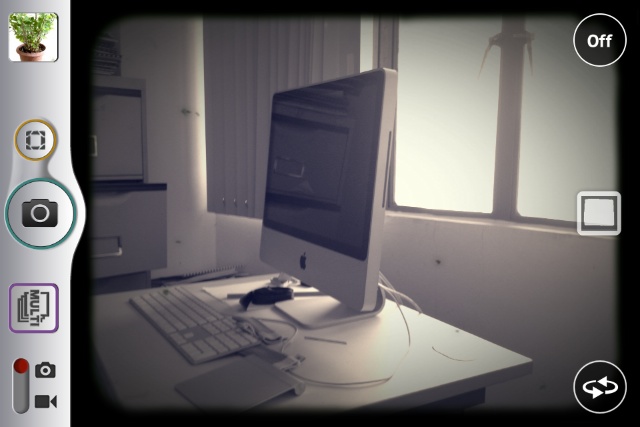Lens+ - An Interesting Effects app for the iPhone and Other iOS Devices

AMITIAE - Wednesday 4 April 2012
|
Lens+ - An Interesting Effects app for the iPhone and Other iOS Devices |
 |
|
|
By Graham K. Rogers
Outline One such app is the recently updated Lens+ (version 3.3.1) which I downloaded a few days ago for free, although the offer may end soon and it will then revert to $1.99.
One such app is the recently updated Lens+ (version 3.3.1) which I downloaded a few days ago for free, although the offer may end soon and it will then revert to $1.99.
The app can apply the 29 filters available via the camera directly. Controls are always displayed at the bottom of the screen when in portrait mode, so when the iPhone camera is held in Landscape, the camera button and other tools are located just beside the Home button. I will run through the controls as shown when in portrait mode.
Lens+The app can apply effects either to still or video output and a switch is available for this on the far right at the bottom. Between this and the camera icon is a tool marked, "Multi". This displays the effects available in 5 groups: Scene, Color, Analog, Fashion and Retro. There are six filters for each (Scene has 5 plus Normal). As each group is accessed, 6 thumbnails showing the separate effects are visible giving a useful quick reference to the style of the photograph.
When a scene is displayed on the main screen, controls for flash and camera (front or back) are visible as well as a small icon showing the type of frame selected. Tapping the screen reveals a zoom slider bar: x1 - x8 (digital zoom). A tiny thumbnail appears in a window at bottom left, when a photograph is taken. Pressing this accesses the Album. Three controls are available: a camera icon to the left, to return to taking pictures; a settings icon to the right, for sound, grid (over the screen), Geotagging and Autosave (there are also settings for Facebook and YouTube accounts); and Export. It is not possible to Export any image unless it is first highlighted. Then, three options are shown: Save, Share and Trash. Save allows a user either to Save and Remove or Save and Keep. Saving puts the image into the iPhone Photo Album. Save and Keep retains a copy in the Lens+ Album as well.
Images imported into Aperture using the iCloud Photo Stream were each 3256 x 2448 (8.0MP) with a file size of 2.81MB. One of those images was exported from Aperture in 8-bit TIFF format and produced an image some 45" x 34" with some excellent, sharp detail. I cropped the date from the two images here.

CommentsWhen the app was in use, it did not use the screen saver function of the iPhone, so I was caught on the hop with a low battery warning. I also noticed that the iPhone was running hot. In normal usage a user would limit the amount of time this was displayed, but I was using the app for extended periods.Lens+ has a lot of flexibility in the way the features are accessed, and the wide variety here makes for some interesting output: still and video. I would like access to the Photo Album of the iOS device as a source. With this type of app, users need to opt for the effect before taking a picture. I prefer to apply effects later and to do this more than once. Lens+ is also compatible with the iPod touch (Generation 4) and the iPads that have cameras, although I only tried it on the iPhone, because of its more useful camera functions.

Graham K. Rogers teaches at the Faculty of Engineering, Mahidol University in Thailand. He wrote in the Bangkok Post, Database supplement on IT subjects. For the last seven years of Database he wrote a column on Apple and Macs. |
|

For further information, e-mail to

|

|